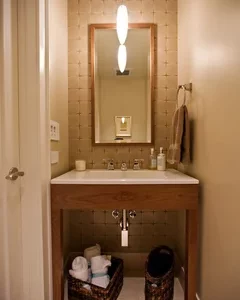Hi all. First time poster.
My wife sent me this picture of a nice open shelf vanity she’d like me to build. I’m trying to determine how they attached the legs as they are flush with the front of the cabinet. I’m new to woodworking and would love to lean on this community for any thoughts or direction you may have.
Much appreciate!
Mike















Replies
If I were to build it exactly like that, I would rabbet two faces of the legs and extend the remainder up inside the skirt to the top.
But I wouldn't do it that way, just because I'm not fond of the look of a wrap-around skirt. I'd make the legs full height and tenon the skirts into the legs.
Both methods work, it just depends on what you think looks better.
Thanks for the comments, John!
Welcome to woodworking. I'm in my fifth decade of making sawdust and I enjoy it more now than I did in the mid-seventies when I started.
I agree that if you're wanting that look, rabbeting the legs is the way to go. A good saw, chisel, and block plane would do the trick if you have them, or you could use a table saw. I'd go the hand tool route if I were you. Starting out with hand tools will give you a better feel for the wood in the long run, as well as more pride in the finished product. When rabbeting the legs, all you really need to get precise is the saw cut where it joins the bottom of the apron. the rest of it doesn't show so it doesn't really have to be perfect, just overall square.
There's a trick when using a handsaw: when you place the saw on the wood, look for the reflection of the wood in the saw blade. If the reflection lines up with the wood, your saw is registered straight. That's most important when using pull saws because it's not easy to get them back on course once you start cutting.
Also, if you start your cut with a few razor knife strokes it will come out cleaner. You can also clamp a block where the saw cut will be as a guide.
Much appreciated, David. I’ll look at rabbeting the legs as you and John suggested. Sounds like a great solution. Also, thanks for the tips!
Do you think doing pocket holes would work (walnut wood)? Rabbeting might be a bit more advanced for me at this point.
If you butted the apron to the legs you could use pocket screws. The look would be different, and perhaps better. On the other hand, half the fun of woodworking is trying something you're not confident with. After decades of bookshelves and dressers, I'm venturing into woodcarving. It started out pretty rough, but I'm getting a bit better. Don't rule out the more difficult approach until you've tried it.
Another idea- glue up the legs using two pieces, one shorter than the other by the width of the apron. The apron then fits perfectly in the leg assembly.
Not a bad idea Elmaduro. So only glue and nothing else holding the pieces together for support?
Others have given the correct answer - rabbets.
The more I look at this item, the more respect I have for the designer.
Whilst it's not my aesthetic, it is extremely well designed to be incredibly cheap.
material - stained pine or cheapest hardwood available.
Cutting list - max of 12 parts (4 aprons, only three show wood; 2 legs, 2 peg legs for the back, 4 corner braces.)
Light on material - I don't do US units really but I'd guesstimate you'd be able to get the whole thing out of a 2" x 8" x 4' board - maybe 6 bf??? (i am sure this is not made that way but just trying to add it up) In black walnut at today's stupid prices that would cost NZD 150 for the lumber. About 100USD more or less. In S4S pine clear - perhaps USD 30. about $1 of stain.
Quick construction - can be screwed together easily.
Robust - see how the legs are deeper than they are wide - allows the legs to look thin, but to stand being kicked - they could be thinner, but this makes the cabinet stronger yet still cheap. I suspect narrower legs would not survive this use scenario.
Simple parts - no complex curves here - nothing you can't make on a table saw with almost zero experience and in no time at all. It's even square so you can't screw up construction and you can pick the best of four faces for the front.
Genius, IMHO.
Were it not for the risk of injury, it'd be fun to see how quickly this could be made, starting with raw lumber. I'm guessing just over an hour, allowing for blade changes and stuff-ups, no distractions and all the tools and pieces ready to hand.
Thanks, Rob! Agreed. The design is simple and very clean. We’re remodeling our kitchen to include lots of walnut so this is a small and inexpensive way to tie it into the overall updated look. You aren’t kidding- wood pricing are insane.
Appreciate all the insightful and thoughtful comments from everyone.
“[Deleted]”
Depends on what I'm making it for... But, if a regular, non-extravagant bathroom, I'm using Kreg screws on the apron.
If it's a finer job (high dollar), I'm doing mortice and tenon construction... Like a typical table.
In my almost 40 years in the trades, it's almost always been the Kreg rout. Not everyone wants to pay for M&Ts.
This forum post is now archived. Commenting has been disabled